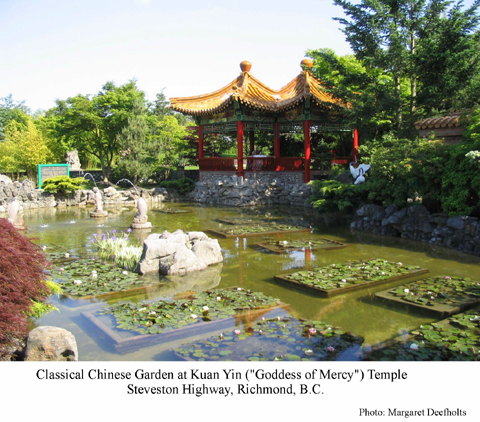PATHWAYS TO HEAVEN VIA RICHMOND, BRITISH COLUMBIA
A year ago when I was in Malaysia, I stayed in a pretty Tudor-style inn, and my itinerary included visits to impressive Buddhist shrines, Hindu temples and Moslem mosques in and around Penang. I think about our own large Asian population in Richmond, and the city’s wealth of temples and cultural landmarks, which are just as riveting as those located in Borneo or India. Because they lie just beyond my backyard fence I’ve taken them for granted (yawn!) never bothering to see them. They are all free, and easily accessible, and a self-guided tour would cost only a few dollars worth of gas, rather than expensive airline tickets. Better still, there’d be no jetlag to contend with either! I decide to treat myself to an overnight stay at the Best Western Abercorn Inn on Bridgeport Road in Richmond. I like the Abercorn: it has personality—a jaunty insouciance—that sets it apart from other bland high-rise hotels in the area. Their Bobby-G Pub (named after the Inn’s little mascot, the legendary faithful-unto-death Skye Terrier, Greyfriars Bobby) is a lively spot, and I’m looking forward to dining once again in their Inglenook Restaurant which has a well-deserved reputation for culinary excellence. Executive Chef Steve Parris’s crème caramel dessert, for instance, is as smooth and sensuous as a caress. Also, with its Tudor architecture, it parallels my Malaysian lodging, and makes a perfect starting point for my Sunday afternoon “temple-crawl” adventure.
I turn into the gates of the Gurusikh Temple on the Westminster Highway around noon the following day. The place is seething with activity, and I don a scarf, shed my shoes and tiptoe to the back of the prayer hall. A reading from the Sikh holy book, the Granth Sahib is in progress; the women and children sit on the deep blue carpet to the left, while the men are on the right. The women make up a shifting kaleidoscope of colours in their kurta-pyjama outfits of parrot green, bright orange, royal purple, inky blue and bubble-gum pink. The reading draws to a close, and the congregation of perhaps 2,500 people, spills out onto the grounds. Everyone is invited to a free Indian vegetarian lunch, and the tantalizing smell of spicy potatoes, cauliflower and lentils wafts down a corridor where people are lined up, waiting for a table. Adults congregate in chat groups, kids shriek as they play tag, and a crowd of teenagers with decidedly Canadian accents, erupt with laughter at a comment made by a pretty girl wearing a traditional Punjabi outfit. Obviously, the Temple (Gurdwara), apart from being a religious venue, is also a lively social meeting place. Although I’m a non-Sikh, nobody appears discomforted by my presence and, as Mr. Bachan Singh Toor, a venerable bearded elder, says emphatically, “Everyone is welcome! I hope you’ll come again.”
Like most Hindu temples in India and the world over, the Ram Krishna Mandir at the Vedic Cultural Centre on No. 5 Road, has an exuberant display of statues representing gods and goddesses from the vast Hindu pantheon of deities. The main stage, festooned in scarlet drapes and marigold garlands, has effigies of the main characters—Ram, Sita, Laxman and Hanuman—from the well-loved epic story of the Ramayana. The goddess Durga (who removes afflictions) is resplendent in a shimmering gold brocade costume; Parvati, the wife of the god Shiva, is dressed in deep pink, with gold embroidery spangling her skirts.
Bimla Veer Singh, Secretary and Co-ordinator of the Centre, greets me with a smile. She is regretful (as I am too) that I’ve missed the Sunday morning devotionals, when oil lamps are lit and sacred mantras are chanted to the accompaniment of temple bells. However, she invites me to join her in their cafeteria, where a free vegetarian lunch is served every Sunday. Over a spicy meal of rice, curried vegetable bhajis and linen-soft rotis, we exchange views on Hindu philosophy. She points out that in addition to Yoga meditation classes, the Vedic Society Centre has recitals, festival celebrations and ceremonial events year round, which she says,“are open to everyone, regardless of race or creed.” No. 5 Road, which Ms. Singh dubs, “the pathway to heaven” has an inordinate number of religious institutions including churches of various denominations. A Moslem mosque (closed on Sunday) stands adjacent to yet another Sikh Gurdwara.
Across the street from a church, the orange tiled roof of the “Pure Land” Chinese Buddhist Ling Yen Mountain Temple shimmers in the afternoon sunshine.
Also along this ‘celestial highway’ is Fantasy Gardens World, where the gods no doubt amuse themselves by swinging on its decorative windmill blades. Although the Kuan Yin, “Goddess of Mercy” Buddhist Temple in the heart of Penang is a popular shrine, it is modest in comparison to the Kuan Yin temple complex on Richmond’s Steveston Highway. And whereas the Ling Yen Mountain Temple is reclusive, the Goddess of Mercy Temple extends a hospitable invitation to tourists and spiritual seekers alike. As I stroll along an entrance pathway flanked by bright flowerbeds, a chubby “Happy Buddha” statue beams a welcome. The Bonsai garden surrounding a lotus pool is serene, and the gentle splash of ornamental fountains lends a dreamy softness to the afternoon air.
The temple’s main building is architecturally dazzling, its glittering gold ceramic roof tiles with their upturned corner “wings” soaring against the sky. I enter the prayer hall, and listen to a sonorous chant, punctuated by drumbeats, as six monks perform their afternoon prayers before an enormous golden image of the Sakyamuni Buddha. The temple also provides visitors like myself a glimpse into Chinese art, and I linger over their display of sculpture, paintings, embroidery, woodcarvings, a splendid ceramic mural, and an intricate bas-relief panel. The exotic, the inspirational, the whimsical and the astonishing—it’s all out there…just over the fence of my backyard. And yours.
|






















